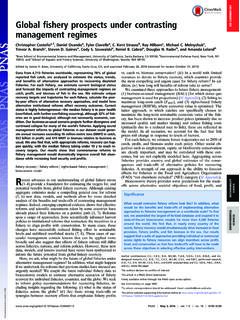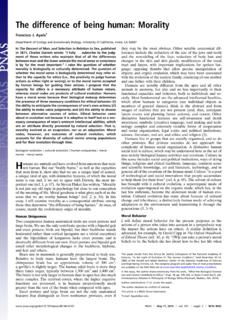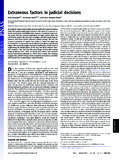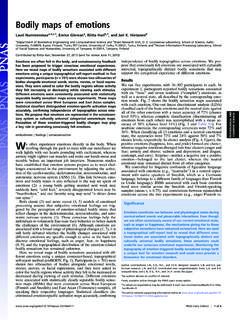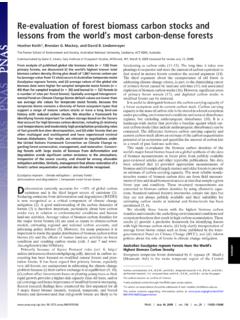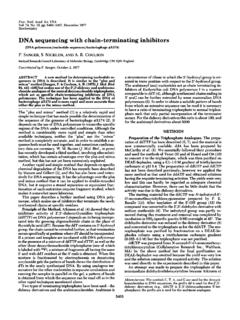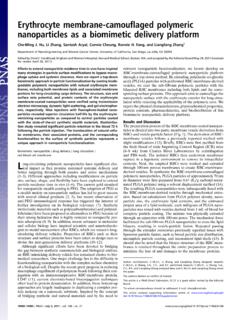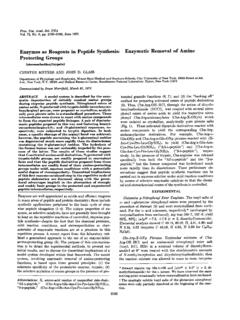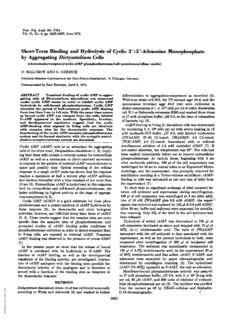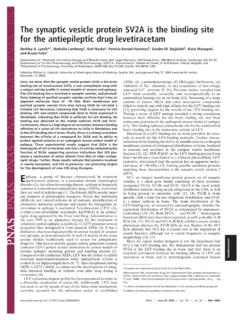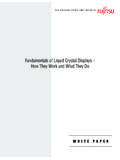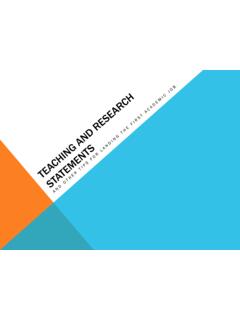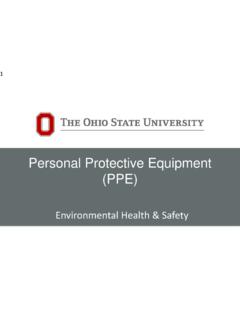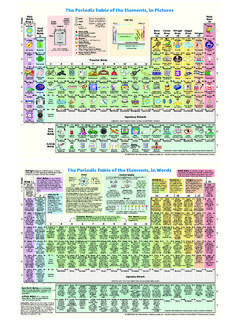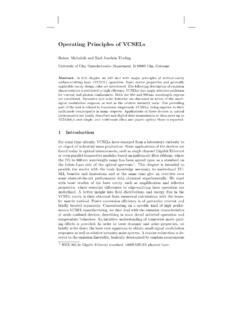Transcription of Drivers of improved PM2.5 air quality in China from 2013 ...
1 Drivers of improved air quality in China from 2013 to 2017. Qiang Zhanga,1,2, Yixuan Zhenga,1, Dan Tonga,b,1, Min Shaoc, Shuxiao Wangb, Yuanhang Zhangc, Xiangde Xud, Jinnan Wange, Hong Hef, Wenqing Liug, Yihui Dingh, Yu Leie, Junhua Lib, Zifa Wangi, Xiaoye Zhangd, Yuesi Wangi, Jing Chenga, Yang Liua, Qinren Shib, Liu Yana, Guannan Gengb, Chaopeng Honga, Meng Lia, Fei Liub, Bo Zhengb, Junji Caoj, Aijun Dingk, Jian Gaol, Qingyan Fum, Juntao Huom, Baoxian Liub,n, Zirui Liui, Fumo Yango, Kebin Heb,2, and Jiming Haob,2. a Department of Earth System Science, Tsinghua University, 100084 Beijing, China ; bState Key Joint Laboratory of Environment Simulation and Pollution Control, School of Environment, Tsinghua University, 100084 Beijing, China ; cCollege of Environmental Sciences and Engineering, Peking University, 100871. Beijing, China ; dChinese Academy of Meteorological Sciences, China Meteorological Administration, 100081 Beijing, China ; eChinese Academy for Environmental Planning, 100012 Beijing, China ; fResearch Center for Eco-Environmental Sciences, Chinese Academy of Sciences, 100085 Beijing, China .
2 G Anhui Institute of Optics and Fine Mechanics, Chinese Academy of Sciences, 230031 Hefei, China ; hNational Climate Center, China Meteorological Administration, 100081 Beijing, China ; iInstitute of Atmospheric Physics, Chinese Academy of Sciences, 100029 Beijing, China ; jKey Laboratory of Aerosol Chemistry and Physics, Institute of Earth Environment, Chinese Academy of Sciences, 710061 Xi'an, China ; kSchool of Atmospheric Sciences, Nanjing University, 210023 Nanjing, China ; lChinese Research Academy of Environmental Sciences, 100012 Beijing, China ; mShanghai Environmental Monitoring Center, 200030 Shanghai, China ; nBeijing Key Laboratory of Airborne Particulate Matter Monitoring Technology, Beijing Municipal Environmental Monitoring Center, 100048 Beijing, China ; and oDepartment of Environmental Science and Engineering, College of Architecture and Environment, Sichuan University, 610065 Chengdu, China Edited by Steven C.
3 Wofsy, Harvard University, Cambridge, MA, and approved October 17, 2019 (received for review May 8, 2019). From 2013 to 2017, with the implementation of the toughest-ever To address severe air pollution issues and protect public health, ENVIRONMENTAL. clean air policy in China , significant declines in fine particle ( ) the State Council of China promulgated the toughest-ever Air concentrations occurred nationwide. Here we estimate the Drivers Pollution Prevention and Control Action Plan (Action Plan) in SCIENCES. of the improved air quality and the associated health benefits 2013 (5), in which concentration reductions of 25%, 20%, in China from 2013 to 2017 based on a measure-specific integrated and 15% in 2017 compared to the level in 2013 were mandated in evaluation approach, which combines a bottom-up emission inven- 3 key regions (depicted in the SI Appendix, Fig. S1): the Beijing- tory, a chemical transport model, and epidemiological exposure- response functions.
4 The estimated national population weighted Tianjin-Hebei region (BTH), the Yangtze River Delta region annual mean concentrations decreased from (95%CI: (YRD), and the Pearl River Delta region (PRD), respectively. In support of the Action Plan, a series of stringent clean air SUSTAINABILITY. ) to g/m3 (95% CI: ) in 5 y, with dominant contributions from anthropogenic emission abatements. Although actions was implemented from 2013 to 2017; as summarized in Fig. 1, these actions include strengthening industrial emission SCIENCE. interannual meteorological variations could significantly alter concentrations, the corresponding effects on the 5-y trends were relatively small. The measure-by-measure evaluation indicated that Significance strengthening industrial emission standards (power plants and emission-intensive industrial sectors), upgrades on industrial boil- The high frequency of haze pollution in China has attracted ers, phasing out outdated industrial capacities, and promoting clean broad attention and triggered, in 2013, the promulgation of the fuels in the residential sector were major effective measures in re- toughest-ever clean air policy in the country.
5 In this study, we ducing pollution and health burdens. These measures were quantified the air quality and health benefits from specific clean estimated to contribute to (95% CI: ), (95% CI: air actions by combining a chemical transport model with a de- ), (95% CI: ), and (95% CI: ) g/m3 declines tailed emission inventory. As tremendous efforts and resources in the national concentration in 2017, respectively, and further are needed for mitigating emissions from various sources, eval- reduced excess deaths by million (95% CI: uation of the effectiveness of these measures can provide crucial ), or 92% of the total avoided deaths. Our study confirms information for developing air quality policies in China as well as the effectiveness of China 's recent clean air actions, and the measure- in other developing and highly polluting countries. Based on by-measure evaluation provides insights into future clean air policy measure-specific analysis, our results bear out several important making in China and in other developing and polluting countries.
6 Implications for designing future clean air policies. clean air actions | PM | emission abatements | air quality improvements |. Author contributions: , , and J. Hao designed research; , Y. Zheng, and health benefits performed research; , , J. Cheng, Y. Liu, , , , , , , , J. Cao, , , , J. Huo, , , and contributed new reagents/analytic tools; , , , Y. Zhang, , , , , , Y. Lei, , , , , , and J. Hao R apid and energy-intensive development in China over the past several decades has led to severe air pollution and negative public health effects, which have become notable environ- analyzed data; and , Y. Zheng, and wrote the paper. The authors declare no competing interest. This article is a PNAS Direct Submission. mental and social problems in China (1, 2). At the beginning This open access article is distributed under Creative Commons Attribution-NonCommercial- of 2013, headlines continually reported the severe NoDerivatives License (CC BY-NC-ND).
7 (particulate matter with an aerodynamic diameter of less than Data deposition: Gridded monthly emission inventory used in this study and gridded m) pollution across the nation. The hourly con- CMAQ model output of monthly mean concentrations are available from http://. centration in the capital of China , Beijing, even increased to 1. , Y. Zheng, and contributed equally to this work. over 1,000 g/m3, which is 40 times higher than the World 2. To whom correspondence may be addressed. Email: Health Organization (WHO) standard level for good health or (3). exposure in 2015 was estimated to result in This article contains supporting information online at Downloaded by guest on January 9, 2022. million deaths globally, among which over a quarter occurred in China (4). First published November 18, 2019. PNAS | December 3, 2019 | vol. 116 | no. 49 | 24463 24469. standards, phasing out small and polluting factories, phasing accounting from 2013 to 2017, and to conduct a measure-by-measure out outdated industrial capacities, upgrades on industrial boilers, evaluation of emission abatements (18, 19).
8 The Weather Research promoting clean fuels in the residential sector, and strength- and Forecasting Model Community Multiscale Air quality ening vehicle emission standards. Detailed information re- Model (WRF-CMAQ) (20, 21) was then applied to simulate var- garding each measure is documented in the SI Appendix, section iations in concentrations from 2013 to 2017, separate the S1. With the implementation of stringent clean air actions, contributions of anthropogenic and meteorological factors to concentration across the country decreased rapidly between 2013 variations, and quantify measure-specific air quality improvements and 2017 (6). (SI Appendix, section S2 and Table S1). Measure-specific abate- It is expected that the implementation of active clean air policies ments in health burdens were then estimated with can achieve remarkable improvements in air quality (7, 8). Recent a set of epidemiological concentration response (C-R) functions studies have reported significant air quality improvements and ( , the Global Exposure Mortality Model, or GEMM) (4).
9 Associated health benefits from 2013 to 2017 in China (9 13). We evaluated the simulated concentrations against Meanwhile, the relative contribution of emission control and in- ground-based observations in 74 cities (536 sites in total; locations terannual meteorological variation to reductions in concen- are shown in SI Appendix, Fig. S1) which had continuous obser- trations has also been identified (14 16). However, no previous vations between 2013 and 2017. The observational data were studies have quantified the impacts of different emission control obtained from the national monitoring network operated by policies on air quality across China during the implementation the China National Environmental Monitoring Center (22). of the Action Plan. Hence, a complete and comprehensive evalua- Although publicly available observation data on chemical tion of the effectiveness of the Action Plan is still missing.
10 Here, we composition was too sparse to support a comprehensive trend systematically evaluated the Drivers of improved air quality evaluation, we compared modeled major composition and the associated health benefits in China from 2013 to 2017, with (sulfate, nitrate, ammonium, organic carbon, and black carbon). an emphasis on the impacts of 6 major control measures with observation data collected from a wide variety of sources (60. summarized from the Action Plan (Fig. 1). As the Chinese gov- sites in total; for site information, see SI Appendix, Table S2). In ernment has put tremendous effort and resources into controlling general, our model simulations well captured the spatiotemporal emissions from various emitting sources, evaluation of the real variations in concentration between 2013 and 2017(SI Ap- effectiveness of these emission control measures can provide pendix, Table S3 and Fig. S2), and model performance was in line crucial information for developing air quality policies in China with other recent regional modeling studies in China (23, 24).
